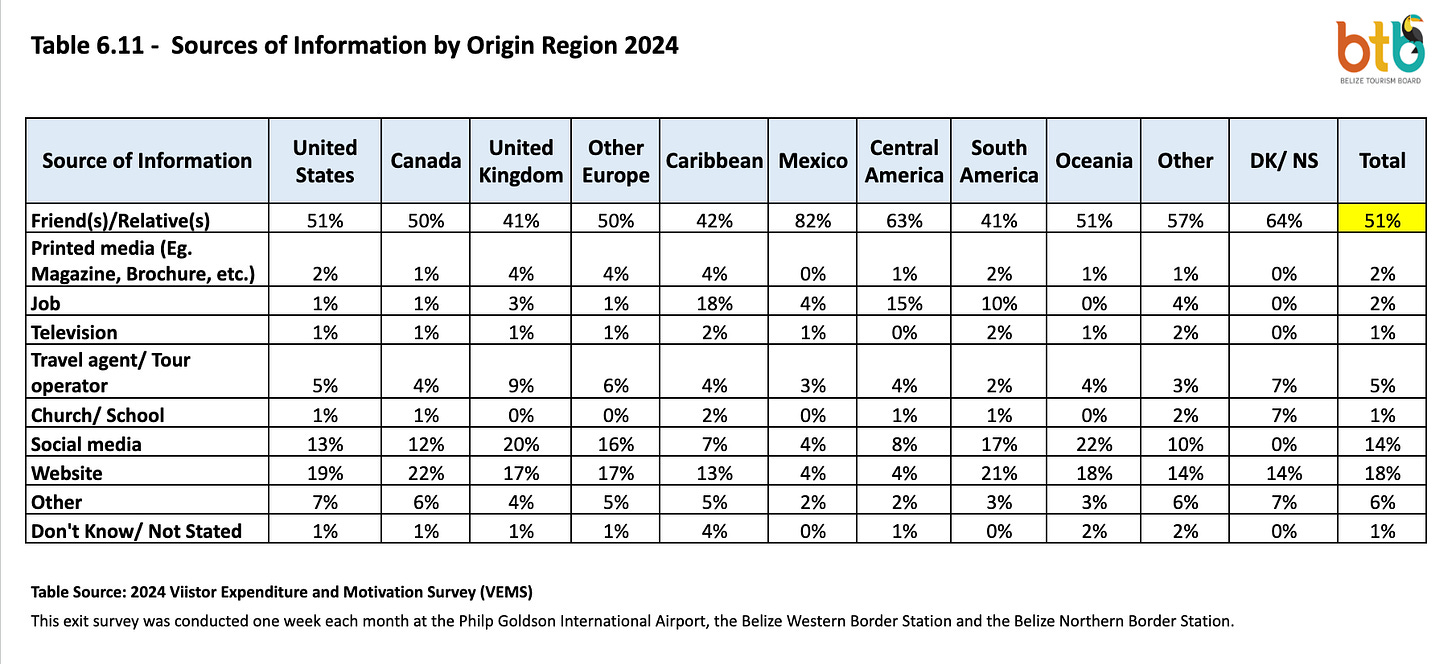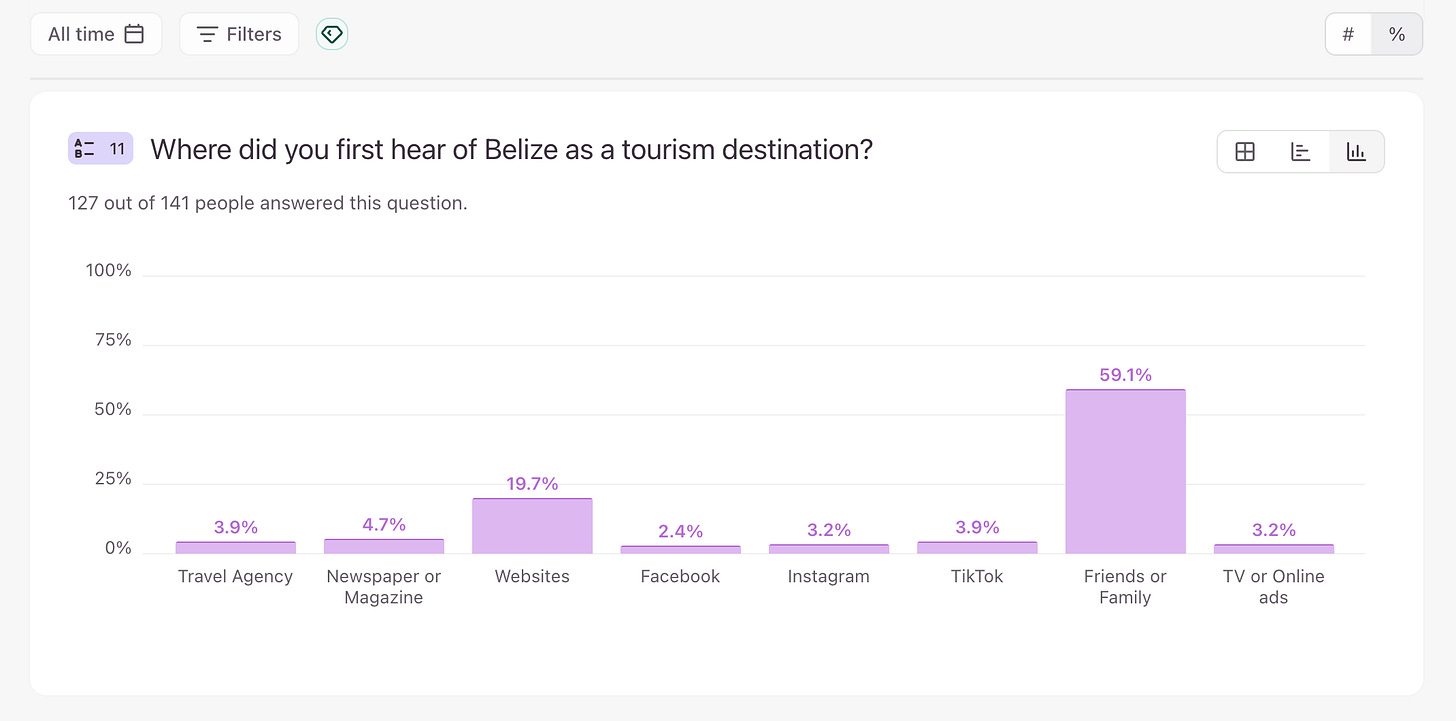Word-of-Mouth: Belize’s Most Powerful Marketing Channel
Half of Belize’s travelers aren’t influenced by ads or search results—they’re influenced by people they know.
According to the Belize Tourism Board’s 2024 Visitor Expenditure and Motivation Survey, 51% of travelers to Belize said they first learned about the country through friends or relatives—almost three times more than the second-ranked source, websites, at 18%.
While social media ranked third at 14%, that distinction may be misleading. Along with online and in-person conversations, most people today see where their friends and relatives travel to through social media posts and stories. Although the survey separates “friends and family” from “social media,” they often capture the same behaviour: people discovering Belize through authentic, personal sharing.
This distinction matters because personal recommendations create effects that marketing alone cannot replicate. When people see or hear about a product from someone they know, they trust it more. That trust makes something like a destination feel more familiar, safe, and desirable. It reduces uncertainty and leaves a stronger emotional impression. It’s not just information; it’s a story connected to feeling, which makes it both memorable and persuasive.
My own year-long survey at Belize Adventure found nearly identical results: 59.1% of visitors said they first heard about Belize through friends or family, while 19.7% cited websites and 9.5% social media. Together, both datasets show the same truth. People trust real experiences shared by those they know, and those stories—passed through photos, messages, or posts—create emotional connections no advertisement can match.
For Belize, the key to growth is not bigger budgets or flashier campaigns. It is creating experiences that people want to talk about and share.
How tourism professionals can capitalize
1. Design shareable moments
Create spaces and experiences that guests naturally want to photograph and share. Vibrant murals, scenic setups, and personalized welcome touches act as emotional anchors that make a destination more memorable. When visitors post these images, they pass on not just what they saw but how they felt, sparking curiosity among friends who start imagining their own trip. Hopkins does this well. Across the entire village you see things that showcase the Garifuna culture.
2. Give guests digital souvenirs
Offer downloadable trip summaries, photo albums, or digital postcards with subtle Belize branding. Capture and share photos of guests during their stay or on tours of Maya sites and marine reserves, then make them easy to download and share. When guests post these keepsakes, they strengthen Belize’s image and make it more memorable for others. Seeing these moments again and again—whether on social media or in private chats—keeps Belize top of mind as an inviting and familiar place to visit.
3. Encourage testimonials and stories
Invite guests to tag your business, use hashtags like #TravelBelize, or share short reflections about their favorite moments. People trust stories from real travelers more than any ads, and these firsthand accounts help others see what makes Belize unique. You can host simple campaigns like Hamanasi’s Photo Contest, where guests share their favorite parts of the trip. When experiences are shared in authentic voices, they become easier for others to believe, remember, and act on.
4. Train staff as storytellers
Equip guides, front-desk staff, and hosts with local stories that add meaning to each experience. When staff weave in history, humor, or personal anecdotes, visitors form stronger emotional connections to the place. Those moments of genuine connection are what travelers remember first and talk about long after their trip ends. I still vividly remember Budge, the tour guide from my Glover’s Reef trip with Island Expeditions, whose deep knowledge of the sea and easy sense of humor brought Belize’s reef and culture to life.
5. Collaborate locally
Coordinate with nearby businesses such as restaurants, tour operators, and lodges to tell a cohesive story about Belize. When travelers see consistent themes across different parts of their trip, it reinforces memory and recognition. A unified identity helps them experience the destination as one connected journey, making it easier to describe, recommend, and share later. Think of how consistently Costa Rica reinforces its “pura vida” message, from ecolodges to airport signage. It creates one clear, unified story.




Totally agree. Was at the NW Chocolate Festival in Seattle last weekend, I felt like the Belize Tourist Board. Had a map of Belize, told people where to stay, what to avoid, when to come. And heard a lot of stories about people's visit from 30 years ago too. And I sold a bit of chocolate.
Super interesting!